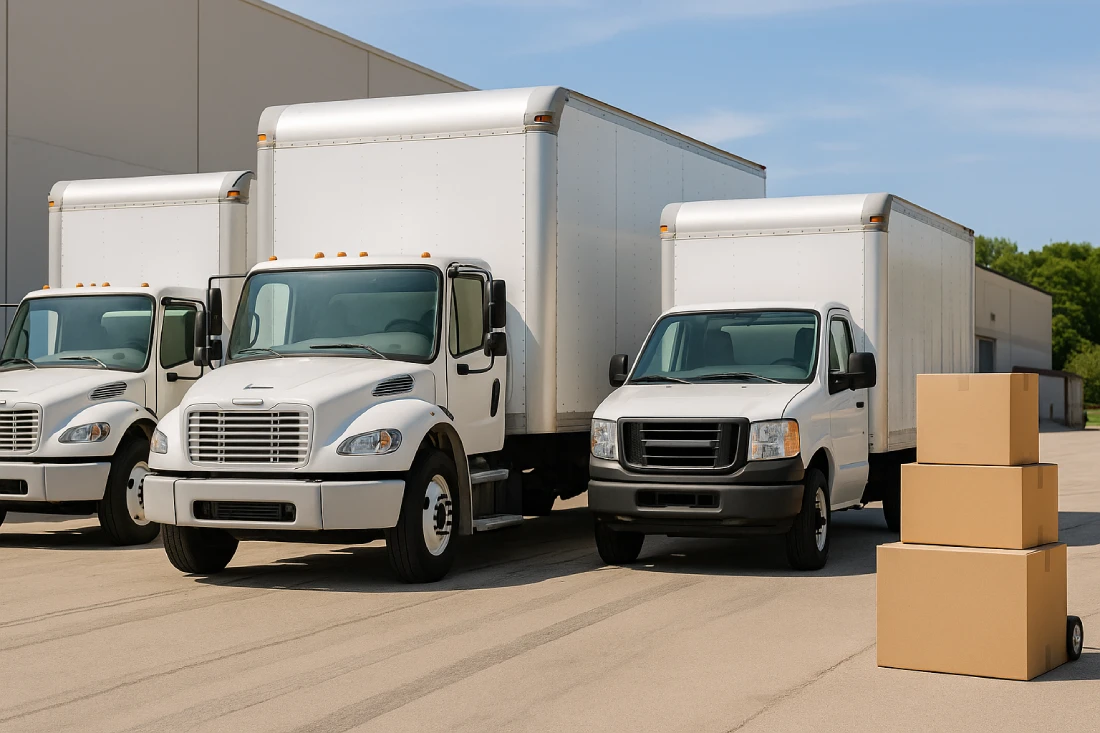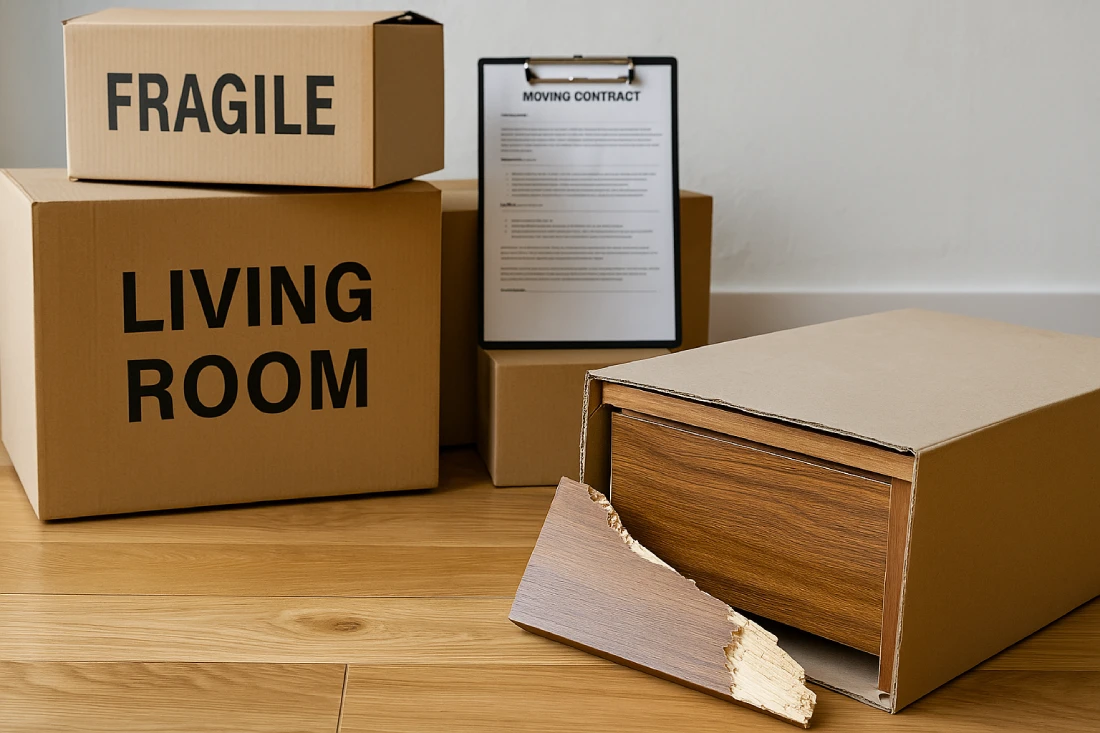Choosing the right moving truck size is a decisive factor for any move. Getting the size right prevents mistakes, such as making extra trips or paying for space you don't use. Learn how you match your home size to the right truck by looking at square footage, room count, and what your belongings are.
We'll share truck measurements, capacity charts, and practical advice for common moving situations, helping you make good rental decisions and avoid last-minute problems.
Moving Truck Sizes: What to Choose Based on Home Size
Knowing your home's layout is helpful when it comes to picking the right moving truck. While each home size usually matches specific truck sizes, things like how much furniture you have and storage contents can change the ultimate size needed. Here's a helpful guide to help you choose correctly.
Moving Truck for Studio or 1-Bedroom Apartments (450-800 sq-ft)
Studio and one-bedroom apartments usually need 400-600 cubic feet of truck space, making 10-12-foot trucks good for these moves. The right choice depends on your specific situation:
- Cargo vans work best for minimalist studios with mostly boxes and small furniture.
- 10-foot trucks fit a queen bed, dresser, nightstand, small couch, and 20-30 boxes.
- 12-foot options have room for apartments with dining sets, multiple closets, or home office equipment.
Most rental companies say that 88% of studio moves work with a single 10-foot truck when properly packed. Consider a 12-foot truck for big furniture, lots of books, or musical instruments.
Best Truck Size for 2-Bedroom Homes (800-1,200 sq-ft)
Two-bedroom homes need 800-1,200 cubic feet of space, making 15-16-foot trucks the common choice. These trucks handle bedroom sets, living and dining furniture, kitchen appliances, and 40-60 boxes.
Industry data shows that 16-foot trucks cut loading time by 25% compared to 15-foot options because of better access and weight distribution. If you're moving from a townhome with garage storage or outdoor furniture, the 16-foot size helps make sure everything fits in one trip.
Moving Trucks for 3-Bedroom Houses (1,200-1,800 sq-ft)
Three-bedroom homes typically have 1,200-1,600 cubic feet of belongings, needing a 20-22-foot truck for safe transport. These vehicles fit:
- Multiple bedroom sets and large dining tables.
- Sectional sofas and major appliances.
- 60-80 boxes with proper weight distribution.
Professional movers suggest 22-foot trucks for homes with children, as toys, sports equipment, and seasonal items often double the expected volume. The extra space allows proper padding between furniture, reducing damage risk by up to 40%.
Truck Requirements for 4 to 5 Bedroom Houses (1,800-2,500+ sq ft)
Large family homes need 26-foot trucks with 1,600-1,700 cubic feet of space and 10,000-pound capacity. These fit 4-5 bedroom sets, multiple living areas, formal dining furniture, and 80-120 boxes with proper organization space.
Statistics show that 26-foot trucks complete 96% of four-bedroom moves in one trip when loaded well. For homes over 3,000 square feet, think about adding a cargo van for workshop equipment, storage items, or collections.
Comparing Townhome and Single-Family Home Moving Needs
Townhomes usually need one truck size smaller than similar single-family homes because they have less storage. A 1,500 square foot townhome often fits in a 16-foot truck, while the same-sized single-family home needs a 20-foot truck for basement, attic, and garage contents.
Single-family homes collect 30-40% more belongings on average because of extra storage space and outdoor equipment. Remember to count lawn tools, patio furniture, and seasonal decorations when selecting truck sizes for single-family properties.
How Heavy Items Affect Your Moving Truck Selection
Certain items greatly impact your truck needs regardless of home size:
- Pianos add 500-800 pounds and need 30-50 cubic feet of secured space.
- Home gyms, gun safes, or hot tubs need reinforced truck floors found in 20-26 foot models.
- Multiple appliances, pool tables, or leather furniture sets often mean you need a bigger truck.
Professional loading data shows that heavy items must be properly distributed to prevent dangerous weight shifts during transport, requiring extra space that smaller trucks can't safely provide.
Complete Moving Truck Dimensions and Capacity Guide
Understanding exact truck dimensions helps you visualize how your belongings will fit and whether you can handle driving larger vehicles. These details help match your needs with the right vehicle while considering practical factors like parking restrictions.
Using Cargo Vans for Small Moves and Quick Hauls
Cargo vans offer 230-250 cubic feet of space with a 3,500-pound capacity, making them ideal for small loads or as an addition to larger trucks. Standard dimensions include 9'6" cargo length, 5'7" width, and 4'8" height, fitting queen mattresses, small furniture, and 10-15 boxes.
These vehicles get 18-20 mpg compared to 10-12 mpg for box trucks, making them cost-effective for short trips. Their compact size allows driving through urban streets, underground parking, and residential driveways where larger trucks can't fit.
10 to 12 Foot Trucks: Perfect for Studios and Small Moves
These smaller trucks provide a good balance between capacity and maneuverability:
- 10-foot trucks: 380-450 cubic feet with 2,850-pound capacity.
- 12-foot models: 450-500 cubic feet with 3,100-pound limits.
- Interior dimensions: 9'11"-12' length × 6'1"-6'4" width × 6'2"-6'6" height.
Low deck heights of 2'5" to 2'9" make loading 30% easier than with larger trucks. Fuel efficiency averages 12 mpg, with daily rentals typically including 60-90 miles before extra charges apply.
15 to 16 Foot Moving Trucks: Ideal for 1-2 Bedroom Homes
Medium trucks offer big capacity jumps with 15-foot models providing 750-800 cubic feet and 16-foot trucks delivering 800-850 cubic feet. Weight capacities range from 4,300 to 6,385 pounds, safely holding heavier furniture and appliances.
These truck sizes get 10 an average fuel economy and have loading ramps rated for 1,000-pound wheeled loads. Their 23-24-foot total length needs longer stopping distances and wider turning space than smaller vehicles.
20 Foot Moving Trucks: Best for 2 to 3 Bedroom Homes
Twenty-foot trucks provide 1,000-1,016 cubic feet of space with 5,600-5,700 pound capacity. These vehicles include several important features:
- Reinforced floors supporting 2,500-pound point loads for safes and pianos.
- Dual rear wheels for stability during transport.
- Air-ride suspensions that protect fragile items.
Operating details include 10 mpg fuel economy, 33-foot turning radius, and 11'8" to 12' total height, requiring bridge clearance awareness. The 26-28 foot total length needs 35-40 feet of straight driveway space for safe loading access.
26 Foot Moving Trucks: Complete Solution for Large Homes
The largest standard rental trucks offer 1,600-1,700 cubic feet of space with a 10,000-pound capacity. Interior dimensions measure 26'2" × 8'2" × 8'3", fitting 12-15 rooms of furniture with proper organization space.
Despite their size, these trucks maintain an efficiency of 10 mpg and don't require special licenses in most states. However, the 35-foot total length, 12'6" height, and 8'7" width require experienced drivers comfortable with large vehicle operation.
Choosing Between Liftgate or Ramp for Your Moving Truck
Loading ramps remain standard on most rental trucks, providing 10-foot angled surfaces for dollies and hand trucks. Standard ramps add 8-10 feet to the required parking length and create 15-20 degree inclines that challenge new movers handling heavy items.
Liftgates remove lifting strain, reducing injury risk by 60% according to insurance data. However, they add $75-150 to rental costs, reduce cargo capacity, and extend loading time by 20-30% due to operation cycles. Choose liftgates for moves involving multiple heavy appliances or when professional help isn't available.
Sizes of Moving Trucks: Find Your Perfect Fit
Direct comparisons between truck sizes reveal important decision factors beyond simple cubic footage. Understanding how each size handles real-world scenarios helps you balance capacity needs with driving comfort and cost considerations.

The jump from 12 to 16 feet nearly doubles capacity while adding only $10-15 to daily costs, making it worthwhile when you're not sure about space needs. However, the 16-foot truck's larger dimensions significantly impact driving in urban areas with tight corners and limited parking.
Twenty-foot trucks hit the sweet spot for suburban family moves, providing professional-grade capacity without requiring much large-vehicle experience. The small fuel economy difference between 20 and 26-foot options makes the larger size appealing for anyone close to capacity limits.
Moving Truck Sizes for Storage Unit Contents
Storage unit moves need different calculations than home moves since items are already packed together. A standard 10x10 unit holds about 800 cubic feet when packed floor to ceiling, needing a 15-16 foot truck. The 10x15 unit contains about 1,200 cubic feet, needing a 20-foot truck.
These recommendations assume 85% loading efficiency, as storage contents often include odd-shaped items and furniture that wasn't professionally packed. Consider these additional factors:
- Many facilities don't allow 26-foot trucks in indoor corridors.
- Ground-level units might need smaller trucks that fit directly against unit openings.
- Climate-controlled units on upper floors present extra challenges with elevator coordination.
Add 20-30% extra space if items have been stored for over two years, as you'll likely need room for sorting during loading. Professional movers suggest photographing storage unit contents before selecting truck sizes.
Using a Moving Truck Size Calculator
A moving truck size estimator turns complex calculations into simple recommendations by analyzing your home's square footage, room count, and furniture inventory. The system multiplies living space dimensions by average possession density factors (7-10 pounds per square foot) and converts to cubic footage requirements.
The recommendation engine compares your calculated volume against standard truck capacities, factoring in:
- Weight limits and loading efficiency rates (85-90%).
- Special items like pianos or hot tubs that impact space requirements.
- A 10-15% buffer for irregular items and loading space.
This numerical approach removes guesswork and reduces costly rental mistakes that affect 23% of DIY movers. Using these tools saves an average of $150-300 by preventing unnecessary second trips or oversized rentals.
Getting the Most Out of Your Truck Space
Properly optimizing your truck space can save you hundreds in rental costs and prevent damage to your belongings. Strategic packing can reduce your truck size needs by 20-25%, directly lowering rental fees, fuel costs, and eliminating costly second trips. Professional loading techniques ensure items arrive undamaged while maximizing every cubic foot.
Many DIY movers rent trucks that are too large or pack inefficiently, leaving valuable space unused. Loading experts use vertical stacking, weight distribution principles, and specialized equipment to safely fit more into less space. This expertise often means downsizing from a 26-foot to a 20-foot truck or from a 16-foot to a 12-foot option. The most cost-effective approach combines a right-sized truck rental with professional loading/unloading help. This hybrid solution gives you control over timing and transportation while eliminating the physical strain and packing inefficiencies. To get the most space and efficiency, consider combining the guidance in this article with proven moving hacks.
FAQs
How much fits in a 26 ft moving truck?
A 26-foot truck fits contents from a 4-5 bedroom home (up to 2,500 square feet), holding 1,600-1,700 cubic feet with a 10,000-pound capacity. This fits 12-15 rooms of furniture and 80-120 medium boxes, including heavy appliances, exercise equipment, and garage items.
What can fit in a 12-foot moving truck?
A 12-foot truck holds about 450 cubic feet, fitting a studio or small one-bedroom apartment with a queen bed, dresser, small couch, kitchen table, and 20-30 medium boxes. It supports standard appliances within its 3,100-pound limit and works well for dorm moves, downsizing, or relocating home offices.
Do I need a special license for a 26 ft truck?
Standard driver's licenses are enough for 26-foot rental trucks in all 50 states as they remain under the 26,000-pound commercial license limit. Some states have restrictions for drivers under 21 or those with recent violations, so check requirements with the rental company.
Will a 26 ft truck fit in my driveway/street?
A 26-foot truck requires 35-40 feet of straight approach space with a total width of 8.5 feet. Most suburban driveways can handle these dimensions, but urban streets with parking on both sides may be challenging, so check local rules and measure clearances beforehand.
How many boxes/furniture fit in each size?
Truck capacity varies by size: 10-foot holds 30 medium boxes plus basic furniture for one room; 16-foot fits 50-60 boxes with 2-bedroom furniture; 20-foot handles 70-80 boxes with 3-bedroom contents; and 26-foot accommodates 100+ boxes with 4-5 bedroom home contents. These estimates assume standard 18"×18"×16" boxes and typical household furniture.
What are the advantages of renting my own truck and hiring moving help?
Renting your own truck and hiring labor-only movers offers significant cost savings of 40-60% compared to full-service companies. You get transparent pricing (around $135 for two helpers), complete control over timing, and flexibility to move at your own pace, all while avoiding hidden fees like travel charges, fuel surcharges, and overnight storage costs. Learn more about comparing moving costs and options.
What size moving truck do I need for an interstate move?
For interstate moves, truck size depends on your home's square footage: 10-12 foot trucks for studios/1-bedrooms, 15-17 foot for 2-bedrooms, 20-22 foot for 3-bedrooms, and 26 foot for 4+ bedrooms. Choosing the right size is critical for long-distance moves—an undersized truck means costly multiple trips across states, while an oversized truck wastes fuel over hundreds of miles. For comprehensive planning advice on all aspects of your interstate relocation, including budgeting, timing, and logistics, see our complete guide on moving to another state.
What's the best straight truck size for moving?
The best straight truck size for most moves is a 26-foot box truck. It offers the optimal balance of capacity (holding 3-4 bedroom homes) and maneuverability, while being drivable with a standard driver's license in most states. For smaller moves (1-2 bedrooms), a 16-20 foot truck is sufficient, while larger moves (5+ bedrooms) may require a full 26-foot truck or professional movers.







































